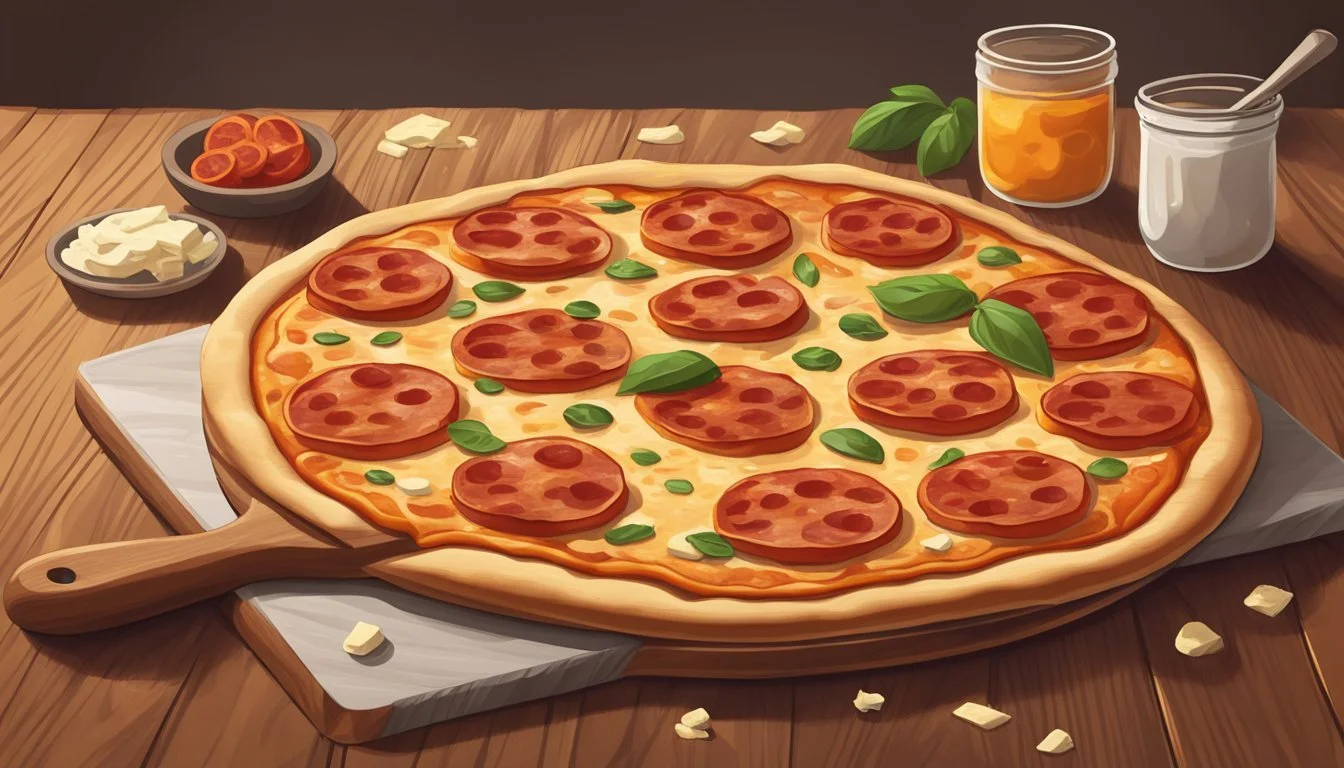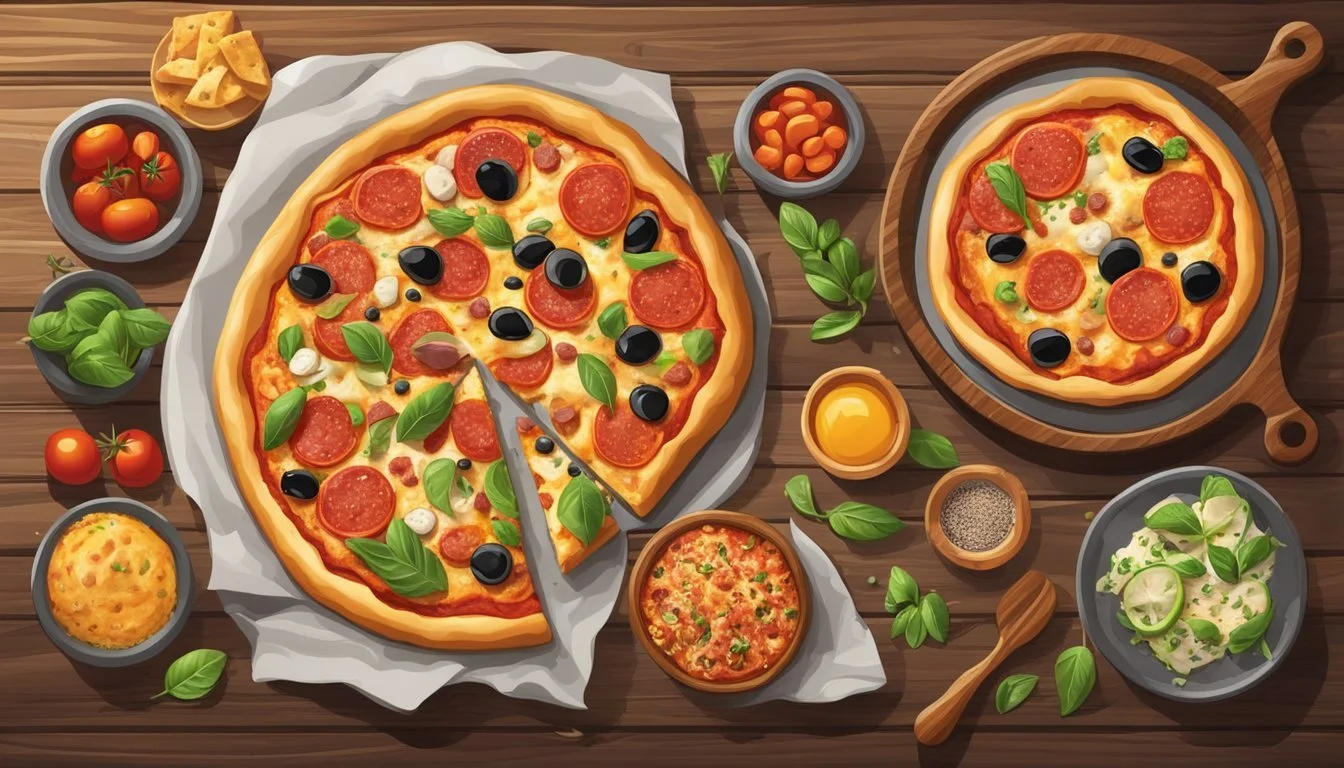How Long Does Flatbread Pepperoni Pizza Last?
Storage Tips and Shelf Life
When it comes to flatbread pepperoni pizza, its shelf life can vary depending on how it's stored. Typically, flatbread pepperoni pizza lasts about 3 to 4 days in the refrigerator. Proper storage is essential; it should be placed in an airtight container or wrapped tightly with plastic wrap to maintain freshness.
If you’re looking for a longer storage option, consider freezing the pizza. Flatbread pepperoni pizza can last up to 2 months in the freezer. Before freezing, make sure to wrap the slices individually or place them in a single layer on a baking sheet to freeze first, then transfer to airtight bags.
Understanding the proper storage techniques not only helps extend the life of your pizza but also ensures that it remains a quick and easy main course whenever you’re ready to enjoy it again. By following these guidelines, you can make the most out of your favorite pepperoni flatbread pizza without worrying about spoilage.
Origins and Popularity of Flatbread Pizza
Flatbread pizza has roots in ancient culinary practices and has evolved over centuries, culminating in beloved varieties like pepperoni pizza, which dominate modern pizza preferences.
Historical Context of Flatbread
Flatbread traces back to ancient civilizations such as the Egyptians, Romans, and Greeks. These cultures enjoyed flatbreads with various toppings, similar to today's pizza styles.
For instance, the Romans had panis focacius, a precursor to modern pizza, showcasing early experiments with bread and toppings.
Cheese introduction in the Mediterranean and the arrival of water buffalo in Sicily around 1000 AD added mozzarella to the mix, setting the stage for the evolution of dishes like Pizza Margherita. Such historical overlaps mark the significance of flatbread in culinary transitions across regions and times.
Rise of Pepperoni Pizza
Pepperoni pizza, a distinctly American innovation, gained monumental popularity in the 20th century. It evolved from the traditional Italian-American adaptation of pizza, heavily influenced by Italian sausage and other meat toppings.
The introduction of pepperoni, with its blend of pork, beef, and spices, provided a spicy and robust flavor that quickly became a favorite.
Restaurants and pizzerias soon capitalized on this preference, making pepperoni pizza a staple on menus across the United States. Its widespread appeal cemented its position not just in American culture but globally, making it synonymous with classic pizza offerings.
Nutritional Information
When consuming flatbread pepperoni pizza, understanding the caloric content, macronutrient breakdown, and the vitamins and minerals it provides is essential for making informed dietary choices.
Caloric Content by Ingredients
Flatbread pepperoni pizza varies in caloric content depending on the brand and ingredients used. For instance, Palermo's flatbread pepperoni pizza contains 420 calories per serving, while Panera's version has 950 calories.
Calories per Ingredient:
Crust: The crust typically includes wheat flour, water, yeast, and oils, contributing significant calories.
Sauce: Made from tomato puree, bell peppers, onions, and oil.
Cheese: High in calories due to its fat content.
Pepperoni: Adds calories primarily from fats and proteins.
Macronutrient Breakdown
The macronutrient composition of flatbread pepperoni pizza includes carbohydrates, fats, and proteins. For a serving of 420 calories:
Carbohydrates: 32% (Approx. 134 calories)
Fat: 53% (Approx. 222 calories)
Saturated Fat: Significant portion of fats, e.g., Panera's version has 26g.
Polyunsaturated and Monounsaturated Fats: Lower quantities.
Protein: 15% (Approx. 63 calories)
These values ensure that the pizza is a good source of energy but can be high in fats, especially saturated fats.
Vitamins and Minerals
A flatbread pepperoni pizza can provide various vitamins and minerals, albeit in different amounts based on the brand and specific recipe:
Calcium: High in cheese, contributing significantly to daily calcium needs, e.g., 40% DV in some varieties.
Potassium and Sodium:
Sodium: Very high, e.g., Panera's version contains 2580mg (112% DV).
Potassium: Present but in lower amounts.
Iron: Contributed by both the crust and pepperoni.
Vitamins A and C: From sauce ingredients like bell peppers and tomatoes.
Given the high sodium and fat content, this pizza should be consumed mindfully, especially by those with dietary restrictions.
Ingredient Profile
A detailed breakdown of the ingredients for flatbread pepperoni pizza is essential for achieving the perfect balance of taste and texture. Each component contributes uniquely to the overall flavor and experience.
Essential Components for Flavor
Flatbread: The base of the pizza, providing a crisp yet tender texture. Choose between store-bought or homemade, using ingredients like flour, water, and olive oil.
Pizza Sauce: Typically made from tomato sauce or marinara, it forms the flavorful foundation. Adding garlic and onion powder enhances taste.
Mozzarella Cheese: Both shredded mozzarella and fresh mozzarella are commonly used. Shredded melts evenly, while fresh provides a creamy texture.
Parmesan Cheese: Sprinkled on top, it adds a salty, nutty flavor that complements the other ingredients.
Sliced Pepperoni: A staple topping that brings a spicy, savory note, crucial for traditional pepperoni pizza.
Olive Oil: Brushed on the flatbread or drizzled on top to enhance flavors and promote browning during baking.
Optional Toppings for Variation
Fresh Basil Leaves: Added post-baking for a pop of color and fresh, aromatic flavor.
Onions: Whether caramelized or fresh, they add sweetness and depth.
Garlic: Minced or roasted, it gives a robust, savory punch.
Italian Cheeses: Varieties like provolone or fontina can be combined with mozzarella for a richer taste.
Tomatoes: Fresh slices or cherry tomatoes add juiciness and a burst of acidity.
Favorite Toppings: Ingredients like mushrooms, bell peppers, or black olives allow for customization and personal preference.
Basil or Parsley: For a herbal, slightly peppery finish, perfect for garnish after baking.
Cherry Tomatoes: Roasted or fresh, they provide a sweet contrast to the savory elements.
By using a combination of these essential and optional ingredients, you can create a flatbread pepperoni pizza that is both flavorful and uniquely tailored to your taste preferences.
Storage and Shelf Life
Proper storage of flatbread pepperoni pizza ensures its longevity. Understanding the best methods for storing pizza and recognizing signs of spoilage can help you enjoy leftovers safely.
Proper Storage Methods
To keep flatbread pepperoni pizza fresh, it's crucial to store it correctly. Refrigeration is a must. Once the pizza has cooled to room temperature, place it in an airtight container or wrap it tightly with aluminum foil or plastic wrap.
Refrigerated pizza should be kept at a temperature between 32°F (0°C) and 40°F (4°C). This temperature range limits bacterial growth and maintains the pizza’s taste for up to 3 to 4 days.
Avoid leaving pizza out at room temperature for more than two hours to prevent foodborne illnesses. When needed, leftovers can be frozen, extending their shelf life to about 2 to 3 months. When ready to eat, reheat thoroughly in an oven preheated to 350°F (175°C) until the cheese bubbles.
Determining Freshness and Safety
Regularly check pizza for signs of spoilage before consumption. Visual cues of spoilage include mold growth or any discoloration on the surface of the pizza.
The presence of off smells can also indicate that the pizza has gone bad. A sour or unpleasant odor is a clear sign to discard it. Textures matter too; a slimy or excessively dry crust signifies spoilage.
Safety comes first, especially for meals like lunch or dinner. Always check the expiration date on store-bought ingredients like pepperoni if making the pizza yourself. Proper inspection ensures pleasant and safe dining experiences each time.
Serving Suggestions
Pepperoni flatbread pizza can be accompanied by a variety of sides and beverages to create a well-rounded meal, whether it's for a weeknight dinner or a casual pizza night. It's important to consider both portion sizes and the best pairings to enhance the dining experience.
Pairings and Accompaniments
Salads: A crisp green salad with vinaigrette complements the rich flavors of pepperoni pizza. Caesar salad is also a good choice.
Sides: Garlic breadsticks, mozzarella sticks, or a simple antipasto platter with olives, cheeses, and cured meats are popular options.
Beverages: For adults, a light beer or a glass of red wine pairs well. Kids might enjoy lemonade or a sparkling water.
Dips: Serve with marinara sauce, ranch, or garlic butter for dipping the crusts.
Serving Size and Portions
Individual Portions: For a weeknight dinner, one flatbread typically serves one adult or two small children. Adjust quantities based on appetite.
Hosting: When hosting, plan on one flatbread per every 2-3 guests if other dishes are available. For larger groups, creating a variety of toppings can cater to different preferences.
Pizza Night: For a family pizza night, prepare an assortment of flatbreads with different toppings to keep everyone happy without overwhelming with too much food.
Leftovers: Pepperoni flatbread pizza can be refrigerated for up to 3-4 days, making it convenient for meal planning and quick lunches.
Recipe Variations and Customizations
Flatbread pepperoni pizza is highly adaptable, offering numerous ways to suit various dietary preferences and tastes.
Alternative Dietary Options
For those seeking a healthier or customized dietary option, several variations are available. Using turkey pepperoni provides a lower-fat alternative to traditional pepperoni. A thin and crispy crust or focaccia can also cater to different texture preferences.
Gluten-free flatbreads are a viable option for those with gluten sensitivity. Opting for a homemade pizza sauce ensures control over ingredients, avoiding unnecessary preservatives. An alternative for those reducing dairy is a vegan cheese or even a pesto base instead of traditional tomato sauce.
To boost nutritional content, incorporate extra virgin olive oil and season with fresh garlic and parsley.
Creative Topping Ideas
Incorporating diverse toppings can transform a flatbread pizza into a unique culinary experience. Classic options like black olives, oregano, and red pepper flakes add traditional flavors. For a BBQ twist, use bbq sauce instead of pizza sauce and top with chicken.
For a fresh take, try a Pizza Margherita style with tomatoes, basil, and mozzarella. Pesto & Chicken offers a vibrant alternative with pesto, cheese, and grilled chicken.
Embrace creativity with combinations such as pepperoni & cheese and personalizing with different cheeses or store-bought flatbread varieties. Introducing unique elements like parsley or elevating the dish with a homemade pizza sauce can also provide a gourmet touch.
Community and Sharing
Engaging with the community and sharing experiences about flatbread pepperoni pizza can enhance the enjoyment and provide valuable insights. Online reviews and social media platforms play significant roles in how people connect over this popular dish.
Discussion and Reviews
People often turn to online forums and review sites to share their thoughts on flatbread pepperoni pizza. Websites like Reddit and food blogs offer a space for enthusiasts to discuss recipes and cooking tips. For instance, detailed step-by-step guides found on popular blogs ensure everyone can join the conversation, from amateur cooks to seasoned chefs.
Reviews on sites such as Yelp and Facebook enable individuals to share their experiences at local pizzerias or review specific products. This feedback not only helps others make informed decisions but also fosters a sense of community among pizza lovers.
Sharing Through Social Media
Social media platforms such as Pinterest, Instagram, and Facebook have become key places to share flatbread pepperoni pizza content. Users post photos, recipe links, and cooking tips, inspiring others with creative ideas for weeknight dinners.
Pinterest, known for its visual content, is effective for bookmarking recipes and discovering new variations of flatbread pizza. Instagram offers a platform for visually enticing photos and short videos, often through hashtags like #FlatbreadPizza or #PepperoniPizza. Facebook groups provide a collaborative space where members exchange advice and share their pizza-making successes.
Involving friends and followers in the pizza-making process can lead to increased engagement and deepen connections within food-loving communities.







